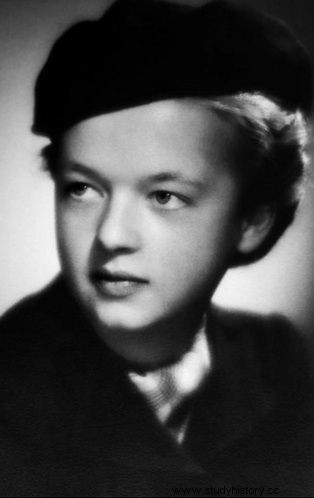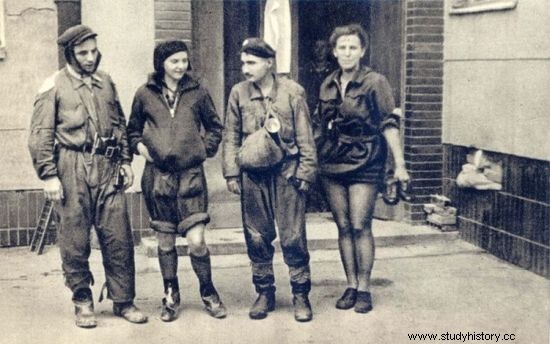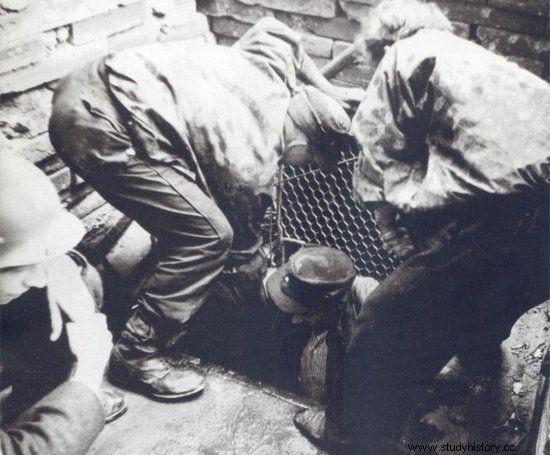The Warsaw insurgents, who found themselves in the sewers during the fights, remember them today as one of their worst experiences. Dirty, dark and smelly, however, saved many lives.
For more than half of August 1944, the Old Town was the scene of the bloodiest fights of the uprising. Cut off from other districts, it waited for extinction. This one came in the last days of the month.
Teresa Łatyńska "Teresa", then a 19-year-old nurse, knew that it was the end. Evacuation to Śródmieście was about to start any day - recalls in Anna Herbich's book "Girls from the Uprising" - Some of them were to go through the sewers, and the rest through the Saxon Garden . It was her share of the transition to the bottom.
The whole operation assumed the withdrawal of the largest possible forces, which were to continue the fight in other districts. In view of the intensifying German attacks, which threatened the Polish positions more and more, this task seemed particularly dangerous. However, this was the only way to fool the enemy, who had cut off all other escape routes.
Amid screams and explosions
The very access to the hatch turned out to be complicated. The evacuation took place in only one place, on Krasiński Square, just a few dozen meters from the front line. There were endless processions from all over the Old Town. The "Teresa" unit went on the night of September 1-2. They tried to move as quickly as possible. In the morning, at seven o'clock exactly, the Germans started bombing.
When we managed to get there, they saw terrifying scenes. Panic. The Germans shoot, and the crowd of civilians presses, tramples to death. Everyone wanted to get out of this hell .

Teresa Łatyńska "Teresa". Photo taken during the occupation.
The gendarmerie guarding the descent to the sewers did not let anyone in. She had a reason. The Germans pumped gasoline inside and set it on fire . The insurgents had to wait.
Panic and death
But how do you do it when it's already dawn? People knew what was next ... Suddenly, planes appeared in the sky! Hundreds of people immediately began to flee. Those who managed to reach the remaining remnants of the walls. The wounded and the weaker huddled on the ground. They hoped that somehow they would survive. Screams of terrified people drowned in the roar of the explosion.
After a while it was over. On Teresa Street, she noticed a lot of the dead. Someone was digging up the buried ones nearby. She tried to help somehow. But there was no more time. They were ordered to enter the sewer. She just left some bandages for the German prisoner-doctor and ran after the others.
The girls and I tied scarves over their heads so that when we come across burning gasoline, our hair does not catch fire . She went from one hell to another .
The most difficult first step
Teresa Łatyńska managed to go down the ladder - not always others. The wounded were often lowered onto a rope. It also happened that people simply fell. Straight into the cold, hideous liquid flowing downstairs.
The first contact with her was not the most pleasant. However, this was not what caused the worst reactions. A few days before "Teresa", Halina Jędrzejewska "Sławka" found herself in the canal. The task of its unit, after walking downstairs, was to attack the Germans at Bankowy Square, thus distracting their attention from the main insurgent forces that were trying to get to Śródmieście. In an interview with Anna Herbich he mentions that the stench was the worst. I have never felt such a stench before and never after. I thought I was going to pass out .

There was a huge responsibility for the guides in the sewers. The lives of the people they led mainly depended on them. The photo shows four sewer guides on the Śródmieście-Mokotów section.
No one was given time to get used to the conditions. The huge queue of people waiting on the surface forced them to move as quickly as possible. Teresa's unit did not wait either. With the rope in hand, it was easy to get lost underground. They started walking.
Stumbling over dead bodies
They were reluctant. Exhausted by several weeks of fighting, carrying weapons and wounded, they had to move almost on all fours, some parts of the canals were only 1.5 meters high. With the water and the impurities pouring into their shoes, they barely lifted their feet.
With each successive meters they encountered more and more obstacles. Before them, many insurgents abandoned their equipment. You had to be very careful not to trip over something. Something or someone. In one place, the stretcher with the wounded man lay directly in the sewer. In the water. Someone dumped this man there … They found the dead in the sewer regularly.
For many, such a sight turned out to be unbearable. They couldn't bear it mentally. An impulse like too high a water level was enough to make them panic. The rest of them had to calm them down immediately so they wouldn't scream. They were afraid that the Germans might hear it. They waited upstairs by the hatches, which they opened from time to time, throwing grenades inside. The slightest noise could have given us away .
This article has more than one page. Please select another one below to continue reading.
Which way to the surface?
The fact that the march underground may be associated with unpleasant surprises, "Teresa" found out the hard way. At one point the worst happened . She realized that the people in front of her are gone!
He understood in a flash. She can't convey to those behind her that she doesn't have a guide! This would lead to panic. Its effects could prove disastrous.
She began to think quickly. First of all, she was not allowed to stop. She wrapped the rope around her arm to keep it taut as much as possible and kept going forward. She believed that they would catch up with the others.
At one point, she saw something that scared her. The channel split into two routes! She didn't know which leg was the right one. Praying mentally, she was looking for some objects at the bottom with her foot that would show her the right path. Some jacket, shoe ... whatever! In vain. Unable to delay any longer, she chose at random.
Saved!
Increasingly tired, she encouraged others not to give up. Suddenly… yes! Yes! Not far in front of her, she saw the flame of a match. Saved! I summoned the last of my strength and quickened my pace, breaking the whole group out of lethargy .
After a few minutes, terribly tired, caked with impurities and smelly but happy, they began to emerge. There was a completely different world waiting for them . Men in jackets. Women in clean dresses. Houses with glass. Trees with leaves. The nightmare of the Old Town has not arrived here yet. But that wasn't going to take long. So far, the refugees enjoyed a moment of peace that they had not experienced in almost a month.

Finally on the surface. The photo shows the sewer exit at ul. Warecka.
The story of Teresa Łatyńska perfectly shows that despite the dramas taking place underground, the canals undoubtedly played a positive role in the uprising. They allowed to save several thousand people, proving the extraordinary ingenuity of Poles. It was appreciated after the end of the fighting by Erich von dem Bach-Zelewski himself, responsible for the pacification of the uprising. He admitted that the Germans had completely ignored the fact that the canals could be used for such a purpose. Earlier, however, the insurgents managed to cheat the enemy twice more with them.
